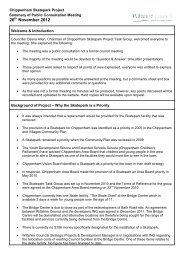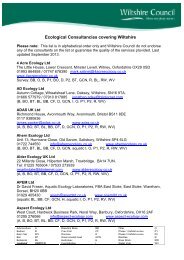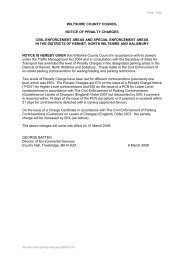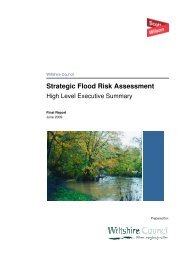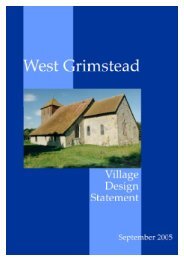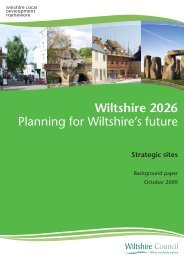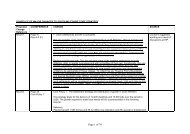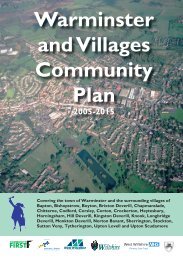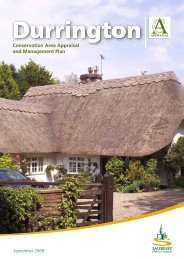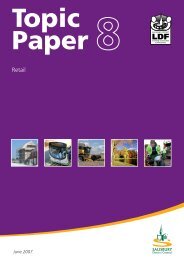South Wiltshire Core Strategy Topic Paper 6 ... - Wiltshire Council
South Wiltshire Core Strategy Topic Paper 6 ... - Wiltshire Council
South Wiltshire Core Strategy Topic Paper 6 ... - Wiltshire Council
Create successful ePaper yourself
Turn your PDF publications into a flip-book with our unique Google optimized e-Paper software.
<strong>South</strong> <strong>Wiltshire</strong><strong>Core</strong> <strong>Strategy</strong><strong>Topic</strong> <strong>Paper</strong> 6 Addendum 2:FloodingJuly 2009
SALISBURY DISTRICT COUNCILLOCAL DEVELOPMENT FRAMEWORKTOPIC PAPER 6 SECOND ADDENDAFLOODINGFEBRUARY 2009
SALISBURY DISTRICT COUNCILLOCAL DEVELOPMENT FRAMEWORKTOPIC PAPER 6 SECOND ADDENDA:FLOODINGFEBRUARY 2009CONTENTS1 INTRODUCTION2 PREVIOUS ROUNDS OF CONSULTATION3 UPDATES TO NATIONAL AND REGIONAL LEGISLATION4 LOCAL EVIDENCE BASE DOCUMENTS5 THE CORE STRATEGY APPROACH AND SUGGESTED POLICIES6 CHANGES AS A RESULT OF SUSTAINABILITY APPRAISAL,STRATEGIC ENVIRONMENTAL ASSESSMENT, HABITATSREGULATION ASSESSMENT AND EDITING REFINEMENT
1. Introduction1.1. Within <strong>South</strong> <strong>Wiltshire</strong> there are five main river systems which include theAvon, Nadder, Wylye, Borune and Ebble. These incised river valleys are a keyfeature of <strong>South</strong> <strong>Wiltshire</strong> and for the main routes for communications andsettlement as well as distractive ecology. Within south <strong>Wiltshire</strong> there are alsonumerous minor watercourses and winter streams or ‘Bournes’.1.2. The River Wyle flows in a south easterly direction from the village of Wyle untilit’s confluence with the River Till. At Witlon the River Wyle flows into theRiver Nadder (which originates in the east) and continues on to Salisbury to itsconfluence with the River Avon. The River Avon is then joined by the RiverBourne and continues to the south where it is joined by the River Ebble. TheRiver Avon then flows south towards the New Forest.1.3. Given that <strong>South</strong> <strong>Wiltshire</strong> owns much of it character due to the waterenvironment, it is necessary to deal appropriately with the issues presented byflood risk. This will become increasingly more important due to the predictedeffects of climate change. Figure 1 below shows the current extent of flood riskwithin <strong>South</strong> <strong>Wiltshire</strong>.Figure 1: Flood Zones 2 and 3 in <strong>South</strong> <strong>Wiltshire</strong>2. Previous rounds of consultation2.1. Both the issues and options consultations and the preferred options consultationsincluded questions relating to flood risk.
2.2. The Issues and Options consultation yielded 420 responses to a question thatrelated to flood risk and new development. Of these respondents, 97.6% agreedor strongly agreed that flood risk should be assed with all new development.Many of the free text comments gave strong support to the principle of notbuilding in areas of high flood risk or on the functional flood plain.2.3. In respect of the preferred options, flood risk was mentioned in numeroussections that dealt with both district wide and community area section policies.The relevant preferred options where…• PO 28a (General)• PO39d (Salisbury)• PO50a (Amesbury)• PO61a (Mere)• PO72a (Downton)• PO73a (Tisbury)2.4. Although the issue of flood risk was included within the above preferred options,all of these options related to the same principle- locating development awayfrom areas of flood risk. The separation of the preferred options over differentgeographic areas did not yield any tangible area specific issues. In light of this itis recommended that issue is covered in one policy.2.5. As with the issues and options consultation, the comments received during thepreferred options consultation where supportive of the notion of locatingdevelopment away from areas of high flood risk. The free text responses to theconsultation can be summarised by the quotes shown below.‘There would be a clear statement under flood protection that the council will not allowdevelopment on flood plains. Whatever developers say, there is no justification possible& these developments threaten the whole community.’‘Assessing the flood risk is insufficient. The planning cycle should be looking to reducethe risk of flooding through inappropriate use of flood plain and, potentially, seek toremove items that compromise the flood plain where this is an appropriate alternative toflood defence measures.’‘The flood risk associated with new development should be properly investigated inaccordance with PPS 25.’2.6. The preferred options II consultation which took place between September andOctober 2009 and included specific questions relating to the allocation ofstrategic housing sites. This consultation did not include any specific questionsrelating to flood risk; however, there are a few free text comments that have beenmade on the issue.
‘There are more paved area, less drains, less vegetation for talking up water - this addsup to increase risk of flooding.’‘There must be no developments not eh floodplains or anything which will in any waydamage the local rivers which are actually national treasures’2.7. Of particular note during all stages of consultation is the representation from theEnvironment Agency (EA) who has a statutory responsibility for flood riskmatters. The EA has been consulted at each of the stages of <strong>Core</strong> <strong>Strategy</strong> andhas attended the Consultative Technical Group which is an open forum ofstakeholder and statutory undertakers. Representations from the EA on theissues and options and preferred options consultations contained more generalcomments about flood risk. However, the comments received during thepreferred options II consultation related specifically to two sites.2.8. The EA comments related specifically to the Churchfields Industrial Estate andthe Central Carpark/Maltings strategic sites. Both of these sites lie partiallywithin Flood Zones 2 and 3 and the EA recommended that a Level 2 StrategicFlood Risk Assessment (SFRA) would be required. The level 2 SFRA willensure that there is a better understanding of flood risk at these two sites. Thiswill in turn enable the sequential test and, if required, the exceptions testsdetailed in Planning Policy Statement 25 to be undertaken.3. Updates to national and regional legislation3.1. Over recent years there have been significant changes to national legislation onflood risk and flood risk management. In 2004 the Government’s Making Spacefor Water 1 strategy set out a new national direction for flood risk managementplanning in England over the subsequent 20 years. The previous strategy waspublished in 1993 and since that time there have been numerous flood eventssuch as those of 1998, 2000, and 2005 and 2007.3.2. The report recognised the requirement for a holistic approach between thevarious responsible bodies, including flood defence operating authorities,sewerage undertakers and highways authorities, to achieve sustainabledevelopment. An integral part of this new direction for flood risk managementplanning in England was the production of a new Planning Policy Statement(PPS). Further research is being carried out in respect of urban drainage andbest practice will be published in due course.3.3. The new national guidance on flood risk and the planning system is held withinthe PPS 25 ‘Development and Flood Risk’ and its associated companion guideThis PPS was published in December 2006 prior to consultation on the corestrategy. The national planning guidance remains unchanged at the time of1 DFRA Making Space for water www.defra.gov.uk/environ/fcd/policy/strategy/projects.htm
writing this addendum. The practice guide which accompanies PPS 25 andgives further guidance on the implementation of flood risk policy was publishedin June 2008.3.4. The Pit Review 2 into the flooding events of June and July 2007 is also of somesignificance and was published in the summer of 2008. The review aimed toprovide a thorough and independent and fair assessment of what happened duringthe worst civil emergency the UK has seen. The report has 92 recommendationswhich cover every aspect of flood risk management and have implications fornumerous national and local organisations. The completed report is beingconsidered by the Government, and until such time as these are aced upon thereare no recommendations which can be directly fed into the <strong>Core</strong> <strong>Strategy</strong>.3.5. Since the publication of the preferred options and preferred options IIconsultation documents, the Secretary of State (SoS) has published proposedchanges to the Regional Spatial <strong>Strategy</strong> (RSS). Policy F1 of the RSS haschanged little when compared to the draft RSS policy. The SoS has strengthenedthe need for Local Planning Authorities to refer to the Final <strong>South</strong> West RegionalFlood Risk Appraisal (RFRA) which was completed in February 2007.3.6. Guidance on flood risk set out in PPS 25 and its associated companion guiderequires Local Planning Authorities to take a proactive approach tounderstanding, avoiding, and reducing flood risk through the developmentprocess. The Environment Agency Flood Map, defines the following zones:• Zone 1 - low risk of flooding• Zone 2 - medium risk of flooding• Zone 3 – high risk of floodingo (a) - has a greater than 1 in 100 annual risk of floodingo (b) - the functional flood plain3.7. PPS 25 sets out formal set of requirements as to what types of development arecompatible and acceptable in each flood zone. The main thrust of policy is todirect development away from areas which are at the highest risk of flooding. Inother words, development should, as a matter of principle, be steered towardsFlood Zone 1 (low risk of flooding). This process is called the ‘sequential test’and needs to be applied at all stages of planning. PPS 25 also sets out thecriteria against which exceptions to this principle might be made. Thesequential test underpins the policy approach that should be taken whenconsidering development at the regional and local level.3.8. The EA, which is a public body, has the main statutory responsibility for floodmanagement and defence in England. The EA provides advice and informationto both developers and LPA’s on flood risk matters. Early engagement with the2 The Pitt Review http://archive.cabinetoffice.gov.uk/pittreview/thepittreview.html
EA is essential in order to ensure that flood risk is dealt with properly. Since thepublication of the preferred options consultation, the EA has reissued revisedstanding advice on flood risk 3 . This advice is a tool to help LPAs establish thelevel of environmental risk involved with planning applications and deal withlow risk applications without the need to consult the Environment Agencydirectly.4. Local evidence base4.1. In line with the guidance set out in PPS 25 and the RSS, a Strategic Flood RiskAssessment for <strong>Wiltshire</strong> has been completed. The SFRA aimed to map allforms of flood risk all forms of flood risk in order to inform the application of thesequential test as set out in PPS 25. The Level 1 SFRA was undertaken jointlywith East and North Dorset District <strong>Council</strong>s and Christchurch and BournemouthBorough <strong>Council</strong>s. This represents a best practice approach as the rivers in<strong>South</strong> <strong>Wiltshire</strong> are part of the Hampshire Avon Catchment which extends wellbeyond the boundaries of <strong>Wiltshire</strong>. One of the fundamental elements of theLevel 1 SFRA is that the impact of flood risk is considered4.2. The Level 1 SFRA was completed in February 2008, but early drafts of the Level1 SFRA outputs document were used to inform the selection of sites. Theapproach to site selection is detailed in the ‘Site Selection <strong>Paper</strong>s 1 and 2’ 4 .4.3. Flood risk was one of the key constraints which were taken into account whenchoosing areas for strategic development sites. The constraint mapping wasused to rule out locations for strategic growth. This approach embodied theprinciple of the sequential test as it ruled out areas in flood zones 2 and 3 thusfavouring development in flood zone 2.4.4. While a large proportion of the strategic sites are located in flood zone 1, thereare 2 exceptions. Both the Churchfields Industrial Estate and the CentralCarpark/Maltings have been identified as key development sites withinSalisbury. The redevelopment of Churchfields Industrial Estate is intended tobe a residential led mixed use development while the Central Carpark/Maltings isintended to be retail led mixed use development.4.5. The Level 1 SFRA has identified that parts of these two sites are within floodzones 2 and 3. The sequential test has been carried out for these two sites and iscontained within the site selection paper 2. Essentially, these sites offersignificant regeneration potential for Salisbury and <strong>South</strong> <strong>Wiltshire</strong> moregenerally and have also been recorded positively in the Sustainability Appraisal.3 EA Standing Advice: www.environmentagency.gov.uk/research/planning/33098.aspx4 Site Selection <strong>Paper</strong>s www.salisbury.gov.uk/planning/forward-planning/local-developmentframework/preferred-options/preferred-options-evidence.htm
4.6. It should be stressed that the selection of these sites has not dismissed flood riskas an issue. In order to ensure that the flood risk is managed property, a Level 2SFRA has been undertaken which looks at flood risk in detail at these sites.4.7. The Level 1 SFRA concerns itself with identifying the extent of flood zones bothwith and without the impact of climate change and is sufficient to undertake thesequential test. The Level 2 assessment is more detailed and included depth andvelocity maps that represent ‘defended’ and ‘undefended’ for both current andclimate change scenarios. The results of the Level 2 SFRA will be used to meetthe requirements of the exception test if required under PPS 25.4.8. At the time of writing, the Level 2 SFRA is in draft format and is awaiting theoutcome of further modelling results. There is also uncertainty over the natureof development on the two sites. However the once complete the Level 2 SFRAdata will be used to direct uses within the site to areas at the lowest risk offlooding. This will effectively mean that the sequential test is applied within thesite at the master planning stage using the matrix of flood compatibledevelopment provided within PPS 25. Where flood compatible developmentcannot be accommodated with areas of lower flood risk within the site, the Level2 SFRA will be used to inform the exceptions test set out within PPS 25.5. The core strategy approach and suggested policies5.1. The overarching approach in the <strong>South</strong> <strong>Wiltshire</strong> <strong>Core</strong> <strong>Strategy</strong> will be theapplication of the sequential approach as defined by PPS 25. This favoursdevelopment in flood zone 1 over flood risk zones 2 and 3 except whereproposals meet the PPS 25 definition of water compatible development.5.2. Whilst the national planning guidance provides the framework the SFRA is thefirst port of call for local information. The SFRA should be used in order toassist in the application of the sequential and exception tests. Developers will beexpected to liaise early with the Local Planning Authority and the EA to ensurethat the adequate consideration is given to flood risk. This will ensure that thecorrect level of information is supplied in the applicants Flood Risk Assessment(FRA) at the planning application stage.5.3. When applying the sequential test, the applicant will need to demonstrate thatadequate consideration has been given to other reasonably available sites. Inorder to pass the sequential test, developers will have to prove that there no othersequentially preferable sites available for development.5.4. Policy HMA11 of the RSS makes a distinction between Salisbury as aStrategically Significant City (SSCT) and the rest of the district. The councilwill adopt the same approach for the geographic area of search over which thesequential test is applied. This is to say that, for proposals in floods risk zones 2and 3 in Salisbury or Wilton, the area of search for available sites will be
confined to these two settlements. Outside of Salisbury and Wilton thegeographic area or search will be the remainder of the south <strong>Wiltshire</strong> excludingSalisbury and Wilton. The area on search may be reduced depending on thefunctional requirements of the development.5.5. Sources of information in respect of alternatively available land are numerousand include the strategic Housing land Availability Assessment, EmploymentLand Review, the National Land Use Database. Evidence of how these sourcesof information have been considered, alongside information of how flood riskhas been compared between sites should be contained within the supportingFRA. Where development is proposed in flood zones 2 or 3, developers will beunable to prove that their sites are sequentially preferable where there is a readilyavailable and deliverable 5 year supply of land.5.6. Information on flood risk changes over time and because of this, the SFRA is aliving document which will need to be updated regularly. The LPA will liaisewith the EA in order to ensure that the SFRA is updated regularly to takes of newinformation.5.7. The management of surface water is an effective way of reducing future floodrisk to both the site and its surroundings. The SFRA recommends that, all newdevelopment irrespective of its type and location should seek to minimise surfacewater runoff. The SFRA also suggests that infiltration drainage techniques,which allows water to be collected and discharged slowly to the subsoil, shouldbe the favoured method of surface water runoff due to the permeable soils in thearea. However, the presumption in favour of infiltration drainage techniquesshould be investigated on site in order to confirm that it is the most suitablemethod of disposal. In some instances infiltration will not be the mostappropriate technique and other methods, such as attenuation tanks, green roofsor rain water harvesting will be more suitable.<strong>Core</strong> Policy5.8. In light of the above, the following wording is suggested for the core strategy.
6. Changes as a result of Sustainability Appraisal, Strategic EnvironmentalAssessment, Habitats Regulations Assessment and editing refinement6.1. The draft core strategy and the initial policy text shown above were subjected toa sustainability appraisal (SA) and also appraisal under the Habitats Regulations,Strategic Environmental Assessment Regulations. These appraisals produced anumber of recommendations for how to improve and strengthen the policy6.2. At the same time as the SA, SEA and HRA assessment of the core strategy, theinitial draft was subjected to editing to ensure that central and regional policy arenot repeated and to take account of recommendations for Government Office ofthe <strong>South</strong> West (GOSW). These editing changes resulted in numerous structuralchanges to the document and also the removal of a number of policies.Suggested Changes6.3. The SA/SEA appraisal of this policy concluded that it performs well against thesustainability criteria. In light of the fact that no adverse impacts werehighlighted, the SA/SEA has not recommended any changes to the policy.6.4. The HRA of the core strategy does not make any specific recommendationsrelating to the flood risk policy. However, the HRA highlights the fact that theflood risk policy goes some way towards protecting the River Avon SAC. Thepolicy offers some protection to the SAC by reducing the potential for diffuseurban run-off through the requirements of SUDS in new developments.6.5. This policy was contained within the development management section of thecore strategy, much of which has been removed. These developmentmanagement policies will now be delivered through the production of a <strong>Wiltshire</strong>wide DPD. However the flood risk policy has been retained all be it in a slightlyrevised format.6.6. The emphasis of the policy is still the same in that it directs development towardsthe lowest areas of flood risk. However, the preamble text and policy have beenedited for clarity and avoid reptition of PPS 25 guidance.6.7. The revised pre amble and policy for the core strategy is as follows….The Strategic Housing Land Availability Assessment (SHLAA) demonstrates that there issufficient land available in Flood Zone 1, the zone of least risk, to meet the housingdevelopment needs of the area. The strategy therefore favours housing development inFlood Zone 1 over areas of higher risk as identified by the Strategic Flood RiskAssessment (SFRA).Proposals put forward in areas of higher risk (Flood Zones 2 and 3) will need to besupported by clear evidence that no lower risk alternative sites are available. The
findings of the SHLAA will carry considerable weight when testing the suitability ofproposals put forward in higher risk areas.<strong>Core</strong> Policy 21 - Flood RiskThe SHLAA and SFRA currently demonstrate there is a readily available and deliverable 5 yearsupply of housing land in Flood Zone 1. Development proposed in Flood Zones 2 and 3 asidentified within the SFRA will need to refer to this information when providing evidence to thelocal planning authority in order to apply the Sequential Test in line with the requirements ofPPS25.All new development will include measures to reduce the rate of rainwater run-off and improverainwater infiltration to soil and ground (Sustainable Drainage) unless site or environmentalconditions make these measures unsuitable.Targets: No approvals against policy or against EA adviceMonitoring and Review: AMR; External reviews (for example by the EA).Delivery Responsibility: <strong>Wiltshire</strong> <strong>Council</strong>; EA; Developers.Policies replaced: G4 and G6



